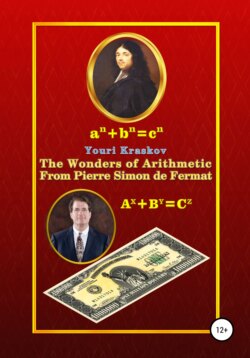Читать книгу The Wonders of Arithmetic from Pierre Simon de Fermat - Youri Veniaminovich Kraskov - Страница 13
3. What is a Number?
3.5. Parity Method
ОглавлениеBefore we embarking on the topic "Fermat's Last Theorem" we note that this problem was not solved by Fermat himself using the descent method, otherwise in his FLT formulation there would be no mention of a "truly amazing proof", which certainly related to other methods. Therefore, to the above examples of the application of the descent method we will add our presentation of two methods unknown to today's science. The most curious of these is the parity method.
3.5.1. Defining Parity as a Number
The Basic theorem of arithmetic implies a simple, but very effective idea of defining parity as a number, which is formulated as follows:
The parity of a given number is the quantity of divisions this number by two without a remainder until the result of the division becomes odd.
Let's introduce the parity symbol with angle brackets. Then the expression ‹x› = y will mean:
the parity of the number x is equal to y. For example, the expression "the parity of the number forty is equal to three" can be represented as: ‹40›= 3. From this definition of parity, it follows:
– parity of an odd number is zero.
– parity of zero is infinitely large.
– any natural number n can be represented as n = 2w (2N – 1)
where N is the base of a natural number, w is its parity.
3.5.2. Parity Law
Based on the above definition the parity, it can be stated that equal numbers have equal parity. In relation to any equation this provision refers to its sides and is absolutely necessary in order for it to have solutions in integers. From here follows the parity law for equations:
Any equation can have solutions in integers if and only if the parities of both its sides are equal.
The mathematical expression for the parity law is WL = WR where WL and WR are the parities of the left and right sides of the equation respectively. A distinctive feature of the parity law is that the equality of numbers cannot be judged by the equality of their parity, but if their parities are not equal, then this certainly means the inequality of numbers.
3.5.3. Parity Calculation Rules
Parity of a sum or difference two numbers a and b
If ‹a› < ‹b› then ‹a ± b› = ‹a›.
It follows in particular that the sum or difference of an even and an odd number always gives a number with parity zero. If ‹a› = ‹b› = x then either ‹a + b› = x + 1 wherein ‹a – b› > x + 1
or ‹a – b› = x + 1 wherein ‹a + b› > x + 1
These formulas are due to the fact that
‹(a + b) + (a – b)› = ‹2a› = ‹a› + 1
It follows that the sum or difference of two even or two odd numbers gives an even number.
Parity of a sum or difference two power number an and bn
If ‹a› < ‹b› then ‹an ± bn› = ‹an›. If ‹a› = ‹b› = x then
only for even n:
‹an – bn› = ‹a – b›+ ‹a + b›+ x(n – 2) + ‹n› – 1
‹an + bn› = xn + 1
only for odd n:
‹an ± bn› = ‹a ± b› + x(n – 1)
When natural numbers multiplying, their parities are added up
‹ab› = ‹a› + ‹b›
When natural numbers dividing, their parities are subtracted
‹a : b› = ‹a› – ‹b›
When raising number to the power, its parity is multiplied
‹ab› = ‹a› × b
When extracting the root in number, its parity is divided
‹ b√a› = ‹a› : b
